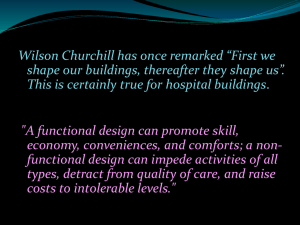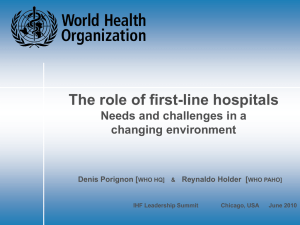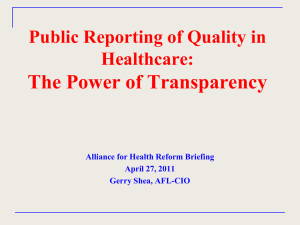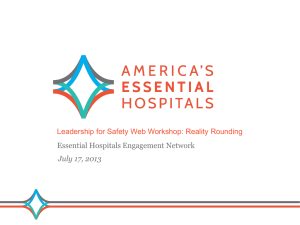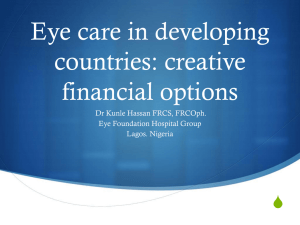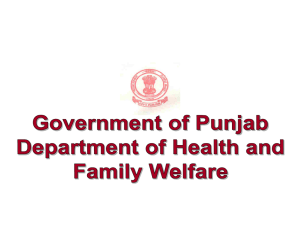Health Care Delivery and Referral System in Thailand
advertisement
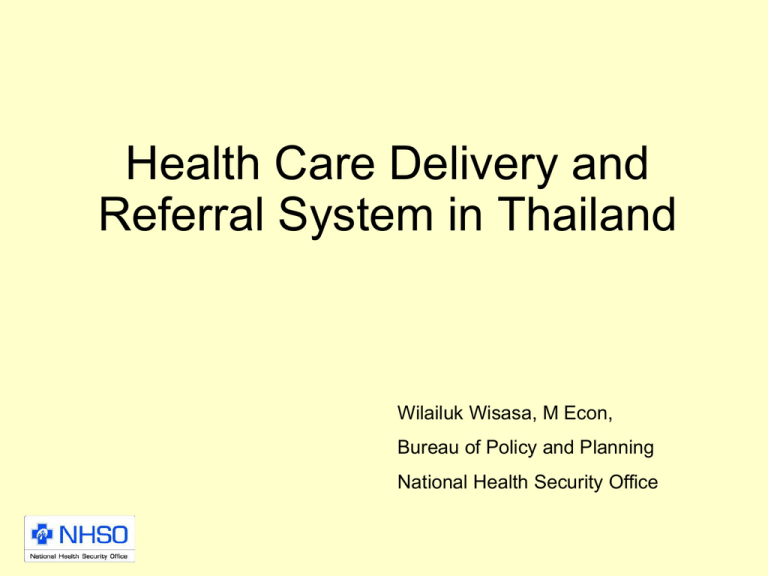
Health Care Delivery and Referral System in Thailand Wilailuk Wisasa, M Econ, Bureau of Policy and Planning National Health Security Office Background GNI/cap - US $ 4,210 (2010) Population - 67 million Total fertility rate – 1.6 (2009) Life expectancy at birth – 74.1 years Under 5 Mortality – 14/ 1000 live births Maternal mortality – 48/100,000 live births 2 Health Expend/cap – US $175 (2009) Physicians/cap – 4/10,000 ANC & SBA coverage - 99-100% (2009). Health Care System in Thailand Government Sector - Ministry of Public Health - Other Governmental Agencies Non-Governmental Organizations Private Sector Health Care Delivery System Government owned 70% of Bed MOPH Facilities Health Center (no Bed) Primary Care Units (PCU) Community Hospital (10-90 Beds) General/Regional Hospital (300-1,000 Beds) Private Hospitals 30% of Bed not-for-profit Hospital for-profit Hospital Public Health Services Facilities • Bangkok 5 Medical school hospitals 29 General hospitals 19 Specialized hospitals and institutions 83 community health care centres •Regional Level 25 Regional hospitals 38 Specialized hospitals • Provincial Level 67 General hospitals (MOPH) 56 Hospitals under Ministry of Defense • District Level 725 Community hospitals 212 Municipal health centers • Sub-district (Tambon) level 9,791 Health centers 72,192 community PHC centres • Village Level 834,711 Village Health Volunteers Primary Health Services in Thailand • Primary Health Services under the responsibility of MoPH: -Health Centres - Primary Care Units (PCU) • Primary Health Services under the responsibility of BMA: - community Health Care Centres Private Hospitals and Clinics 436 Private hospitals (Bangkok 115, other provinces 321) 10,819 Medical clinics 11,094 Drugstores 2,106 Traditional medicine drugstores. 7 Health Service Delivery Infrastructure (Ministry of Public Health) • • • • • • Regional Hospitals General Hospitals Community Hospitals Health Centers Community PHC’s Centres Other Hospital (Under Department) • Village Health Volunteers 25 67 725 9,738 72,192 25 834,711 Health Service Infra-structure Excellent Centers General, Regional Hos.(95) Community Hos.(741) 3 o MC 2 o MC Health Center (9,770) 1 o MC CPHC. Center (80,000) PHC SELF CARE Province( 200,000-2M.) District(10,000-100,000) Subdistrict(1-5,000) Village Family Thai Health Care Structure Principles • Equity 2 Million Ex.cent. • Accessibility 1 Million Tertiary Care • Quality 0.2 Million 80,000 30,00-50,000 10,000 Referral System High level Middle level Secondary care Low level Primary Care Community-Family-Self Care Health Infrastructures Community Hospital Main Primary Care Unit (PCU) Health center – close to client PCU Population Ratios of Major Health Personnel in Thailand (2008) Region • • • • Bangkok North Northeast Central Doctors Dentist Pharmacists Nurses 1:756 1:2,975 1:2,121 1:4,862 1:27,188 1:16,588 1:8,062 1:38,232 1:25,783 1:3,620 1:17,334 1:11,353 1:303 1:1,021 1:1,696 1:847 1:4,825 1:25,334 1:13,210 1:3,395 1:15,295 1:10,158 1:961 1:905 (Except BKK) • South • Whole country Model on Referral System Development Community Hospital Referral Center (Region) • Situation Assessment • Support Resources HC Community Hospital • Monitoring &Evaluation Community • Share Resources Hospital Regional Coordinating Referral Center Regional/General Hospital General Hospital Community Hospital Center High Care Continue/Chronic Care, Home Care HC •Technical Support •Update data Referral Community Hospital •Staff 24 Hrs. HC General Hospital Center HC General Hospital Referral Referral Community Hospital Community Hospital HC Center HC HC Stimulus Package Plan (SP II) Ex. • 10 Centers for 2010-2014 Centers showing Health • Health Manpower Development • 163 [Production : 1,620 Doctors, 2,500 Nurses, 6,000Asst. Nurses 10,376 MB. [ 40 Cardiac, 26 Cancer, 51 Trauma] • 1 Thai Traditional Medicine products ( 17 MB) 10 Health production offices(7 MB) 395 MB. 400 Dental Public Health , 4,800 Food Safety 750 Health Technical Officers, Tertiary Care places (12 MB) Capacity Building : 115 Regional/General Hospitals 22,302 MB. 25,000 persons] 2 Elderly Health Care Services 76 MB Centers 5,870MB. Sounthern Border Health Development (2,659 MB) Secondary Care 235 Node of Community Hospitals 13,499 MB. Primary Care 14,763Tambol Health Promoting Hospitals 14,763 MB Supportive Health Services System • 1,100 Accommodation Units, Offices, Cars • 1 Health Information System Infrastructure • 18 Referral Health Service Centers 14,625 MB. 2,974 MB. 616 MB. 14 Projects for Investment in Health Development ( 86,685 Million Baht) The Three Main Financial System in Thailand • Civil Servant Medical Benefit Scheme (CSMBS) and State Enterprise Benefit. It is not social insurance scheme but in stead it serves as fringe benefit for Govt. officers and operated by Ministry of Finance. • Social Security Scheme (SSS) for employees working in the private company with employs more than 1 employee • Universal Coverage Scheme (UC) for the rest of the population Enabling Factors for Achieving UC • Strong political support • Health system capacity and its resilience to rapid nationwide program scaling-up • Nationwide extension of PHC coverage, and mandatory rural health services by new graduate medical doctors and other health workers • Integral relationship among researchersreformists-politicians UC Benefit Package • It is quite comprehensive comprising OP, hospitalization, health promotion and disease prevention, most of high cost case, dental care, medicines, operations including heart surgery, HIV/AIDS treatment and prosthesis replacement Except: special nursing fee, eye glasses and some really high cost treatment Policy Recommendations and Perspective for the Future ◙ Strengthening the national policy and strategic approach with participation of all stakeholders to drive and formulate integrated action plans and necessary associated implementation. ◙ Increasing accessibility in quality health services for all and to invest in cost-effectiveness interventions. ◙ Strengthening to success in higher level of primary health care, community health care services, comprehensive national health promotion program, and decentralization in health. ◙ Preparation for elderly: economic security, health security, social security

